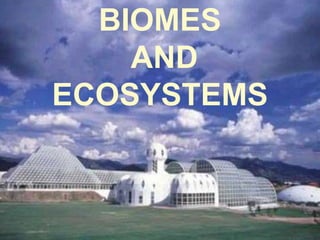
BIOMES AND ECOSYSTEMS (1).ppt
- 2. What is a biome? • A biome is a group of land ecosystems with similar climates and organisms
- 3. There are 6 major land biomes and 2 major water ecosystems? LAND (6): RAINFORESTS, DESERTS, GRASSLANDS, DECIDOUS FORESTS, BOREAL FORESTS, & TUNDRA WATER (2): FRESHWATER & MARINE ECOSYSTEMS
- 4. • An area’s biome is determined mostly by its climate (temperature and precipitation)
- 5. RAIN FORESTS • There are 2 main types of rain forests: Temperate Rain Forests and Tropical Rain Forests.
- 6. TEMPERATE RAIN FORESTS • “Temperate”= having moderate temperatures. • Northwestern coast of U.S. is a temperate rain forest. • Receives more than 300 cm of rain per year. • Huge trees: Cedars, Redwoods, Douglas Firs.
- 7. TROPICAL RAIN FORESTS • Found in regions close to the equator • Warm and humid all year long. • Lots of precipitation. • Diverse plant growth.
- 8. • Trees in the rain forest form several layers… Canopy: A leafy roof formed by the tallest trees. Understory: A second layer of shorter trees and vines.
- 9. • Understory plants grow well in the shade formed by the canopy, but the forest floor is nearly dark and only a few plants live there.
- 10. DESERTS • Desert = An area that receives less than 25 cm of rain per year. • Some deserts receive NO precipitation at all during one year. • Deserts often undergo large shifts in temperature during the course of a day.
- 11. The scorching Namib desert in Africa cools rapidly after the sun goes down. The Gobi desert in central Asia is cooler and even experiences freezing temperatures in the winter.
- 12. • Organisms that live in the desert must be adapted to the lack of rain and extreme temperatures. – Saguaro Cactus: Stem expands to store water. – Gila monster spends weeks in its cool, underground burrows. – Many other organisms are only active at night when it is cooler.
- 13. GRASSLANDS • Grassland (prairie)= An area that is populated mostly by grasses and other non-woody plants. • Receive 25 to 75 cm of rain per year. • Fires and droughts are common.
- 14. Savanna: Grassland that is located closer to the equator than prairies. – Savannas can receive as much as 120 cm of rain per year. – In addition to grass, scattered shrubs and small trees can grow in the savanna.
- 15. • Grasslands are home to many of the largest animals on Earth. • Examples: • Grazing by these large herbivores helps to maintain these grasslands.
- 16. DECIDUOUS FOREST • Deciduous trees= Trees that shed their leaves and grow new ones each year (Oaks, Maples…) • Receive enough rain to support the growth of trees and other plants (at least 50 cm per year). • Growing season is 5 to 6 months long.
- 17. BOREAL FOREST (taiga) – Mostly contains coniferous trees (trees that produce their seeds in cones and have leaves shaped like needles). Ex. Fir, Spruce, Hemlock… – Very cold winters (a lot of snow). – Warm and rainy summers.
- 18. TUNDRA • Tundra = Extremely cold and dry biome. • Usually receives NO more precipitation than a desert biome. • Most soil is frozen all year long (permafrost) • During summer, the top layer of soil thaws, but the rest remains frozen. PERMAFROST
- 20. o Because rainwater cannot soak into the permafrost, there are many shallow ponds and marshy areas of the tundra during the summer
- 21. Tundra Plants and Animals POLAR BEAR WOLF REINDEER ARCTIC FOX ARCTIC HARE
- 22. FRESHWATER ECOSYSTEMS • Freshwater ecosystems include streams, rivers, ponds and lakes.
- 23. Rivers and Streams – Animals adapt to the stream/river’s current (hooks and suckers to cling to rocks, streamline bodies). – Few -plants or algae can grow because of the strong currents. – Animals rely on seeds and leaves to fall in the water as food.
- 25. Ponds and Lakes – Bodies of standing or still freshwater. – Lakes are larger and deeper than ponds. – Ponds: Shallow enough for sunlight to hit bottom (allowing plants to grow there). – Lakes (and large ponds): Too deep for plants to grow on the bottom, so algae grows and floats on top of water.
- 27. MARINE ECOSYSTEMS • Marine ecosystems include estuaries, intertidal zones, neritic zones, and the open ocean.
- 28. • Estuary: Where freshwater of a river meets saltwater of the ocean.
- 29. Intertidal Zone: The area between the highest high tide line and the lowest low tide line. • Organisms here must be able to survive the pounding waves, water level changes, and temperature changes • Ex. (barnacles, starfish, snails, clams….)
- 30. Neritic Zone: The area below the low tide line which extends over the continental shelf. • Sunlight passes through this zone, so photosynthesis can occur (plants can grow). • Many living things. • Coral reefs may form in water is warm.
- 31. Open Ocean: Separated into two zones: • Surface Zone: The first few hundred meters deep of the ocean (where light penetrates). • Deep Zone: Below the surface zone (totally dark and home to many BIZZARE organisms). SURFACE DEEP
